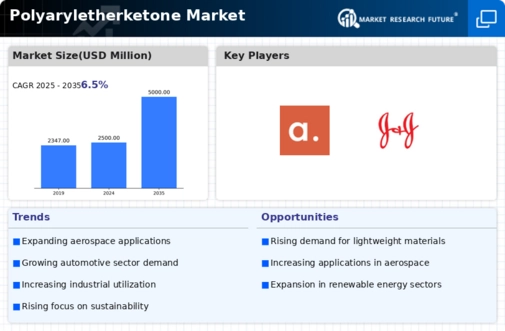Polyaryletherketone Size
Polyaryletherketone Market Growth Projections and Opportunities
Market Factors of Polyaryletherketone (PAEK) Market:
End-Use Industries: The demand for polyaryletherketone (PAEK) is heavily influenced by various end-use industries such as aerospace, automotive, electronics, oil and gas, and medical devices. PAEK's exceptional properties, including high temperature resistance, chemical resistance, mechanical strength, and flame retardancy, make it a preferred material for demanding applications in these industries, thus driving market demand.
Technological Advancements: Ongoing advancements in polymer chemistry, processing techniques, and material formulations contribute to market growth. Innovations in PAEK production methods, polymer blending, and additive incorporation enhance material performance, processability, and cost-effectiveness, leading to the development of new applications and market expansion.
Regulatory Compliance: Compliance with regulatory standards and industry specifications significantly influences the PAEK market. Regulations related to product safety, environmental impact, and performance requirements drive manufacturers to develop PAEK formulations that meet stringent standards, shaping market dynamics and consumer preferences.
End-User Applications: PAEK finds diverse applications across various industries, including aerospace components, automotive parts, electronic connectors, oil and gas components, and medical implants. Changes in these industries, such as technological advancements, regulatory requirements, and market trends, directly influence the demand for PAEK and drive market growth.
Market Competition: The PAEK market is characterized by intense competition among manufacturers, with key players competing based on factors such as product quality, performance, pricing, brand reputation, and innovation. Market players invest in research and development to introduce new PAEK grades, improve processing techniques, and expand their application portfolios, driving market growth and enhancing competitiveness.
Raw Material Prices: Fluctuations in the prices of raw materials such as aromatic dihalides and aromatic diols impact the production costs and profitability of PAEK. Volatility in raw material prices, supply chain disruptions, and geopolitical factors influence market dynamics, affecting pricing strategies and investment decisions within the industry.
Global Economic Conditions: Economic factors such as GDP growth, industrial production, and consumer spending patterns influence the demand for PAEK. During periods of economic expansion, increased industrial activities, infrastructure development projects, and consumer spending drive market demand, whereas economic downturns may lead to decreased demand and market volatility.
Emerging Market Opportunities: Growth opportunities in emerging economies present significant prospects for the PAEK market. Rapid industrialization, urbanization, and infrastructure development in regions such as Asia-Pacific, Latin America, and Africa drive the demand for high-performance materials like PAEK, fostering market growth and expansion.
Environmental Sustainability: Growing awareness of environmental sustainability drives the demand for eco-friendly polymer solutions. Manufacturers are increasingly focusing on developing bio-based, recyclable, and low-toxicity PAEK formulations to reduce environmental impact and meet sustainability requirements, influencing market trends and consumer preferences.
Technological Adoption: The adoption of PAEK materials in new applications and industries contributes to market growth. As technological advancements enable the development of innovative products and processes, the demand for high-performance materials like PAEK increases, creating new market opportunities and driving market expansion.






Leave a Comment